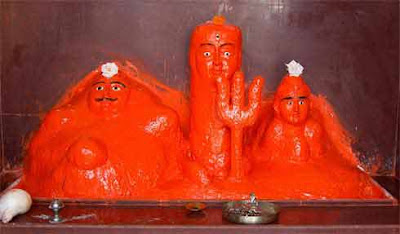
Kuladevata (kula-dèvatā) Marathi: (कुलदेवता) or Kuladevi (कुलदेवी) also known as Kuladev (कुलदेव)
and Kuladaivat, (कुलदैवत) stands for “family deity, that is either a god or a goddess” within Hinduism, as distinct from personal ishta-devata and village deities.
Kuldevi mantra: Om Shri Kuldevyai Namah, shri kuladevatayai namaha, jai kuladevata, jai kuladevi.
The word Kuladevata is derived from two words: Kula, meaning clan and Devata, meaning deity. Thus, it can be said that Kuladevatas are deities which are worshiped by particular clans. The deity can be a male, female, animal or even an object, like a holy stone. Hindu families make a pilgrimage to the Kuladevata or Kuladevi temple to obtain the blessing of the deity after an auspicious occasion such as a wedding. Kuladevatas are worshiped in several sects of Hinduism and Jainism. In the state of Maharashtra, the Kuladevatas are mainly manifestations of Shiva or Shakti such as Khandoba or Bhavani, respectively. In the states of Gujarat and Rajasthan, these deities are generally, the various manifestations of Parvati, the consort of Shiva. She is worshiped by different names by different clans. The Indian King Cobra(Nag) is also a famous Kuladevata. It is known by several names, such as, Nagadevata and Nagabaapji and is worshiped by several Hindu, Jain and Kshatriya clans. Some Kshatriya clans also claim themselves to be “Nagavanshi” or Descendents of the Naga.
In South India, Balaji of Tirupati is one of the main Kuladevatas.
In Kerala, amongst the Nair community, each tharavadu (ancestral family house) has a Kula Devata – often, the devi form of Bhadra, besides Para Devatas of ancestors in tharavadu temples. However, each branch of the family and members are also worship Ishta-Devata depending upon village deities and choices.
In Andhra Pradesh, Goddess Vasavi Kanyakaparameshwari is the Kuladevi for the Arya Vysya community.
In Tamil Nadu, Goddess Kamakshi and Lord Muruga are family deities for many Brahmin Iyers and also to Maravar And Vellalars. Goddess Bhadrakali is the tutelary deity of Nadars. Majority of the Nadar Settlements will have a temple for Goddess Bhadrakali. Goddess Angalaparameshwari for majority of chettiars and vellalars. Lord Narashima for Brahmin Iyengars and also to Naidu. Worship of Kuladevta is very much prominent amongst the Brahmins and Kshatriyas of Goa, Karnataka and Maharashtra, that are the Konkani Saraswats and Daivajna. Most of the Kuldevta temples are found in Goa, Shantadurga, Mahalakshmi, Nagesh, Mangesh, Ramnath to name a few. Kuladevtas play a very pious role in the Konkani Saraswats and Daivajna Brahmins, it can even supplant the role of the Istadevta.
Worship of the kul-devata or kul-devi is considered to be of utmost importance. The Kul-devata is the guardian of the family, of the lineage. Ancestors of the family have worshipped the deity and there is a bond between the family and the deity. Hence such worship bears fruits early. Worship of the kuldevata is said to appease the deity who is the sole protector of the family. One who worships his/her family deity is said to be protected by the deity in times of calamity.
Kuldevta, also known as Kuladevta or Kuldevi or Kuldevata, is the concept of family deity in Hinduism. This tradition is strictly followed by many Hindus but sadly, several Hindus also have lost this tradition or stopped following it. Vedic Rishis keeping in mind the future needs of people especially when people will drift away from studying of Vedas designed the concept of Kuldevta.
Vedic Rishis very well knew that in future people under the influence of Kali Yuga would not be learning Vedas. To help them overcome the difficulties of not learning Vedas, the Rishis designed beeja mantras.
Chanting of the beeja mantras helped people overcome difficulties. The mantra was primarily conceived to overcome all sort of weaknesses. When weaknesses were removed people attained peace and prosperity.
Further intense chanting of the Beeja mantras gave rise to mental forms. This was later given physical form by Rishis and thus we have Kuldevta deities.
The beeja mantra for a family depends on the ancestors, the place they are residing, climate and environment. Each family has a particular weakness and strength. The Kuldevta and beej mantra of family is conceived to remove the weakness and enhance strength.
The concept of Kuldevta also kept in mind the health related troubles of a family.
When chanted properly, Beeja mantra ushers in change in thinking pattern and reinvigorates the brain cells and veins. The chanting should be done with a mental picture or physical form of the Kuldevta.
Today many people are not aware of their Kuldevta. They have lost contact with their roots. Most of the difficulties such people face can be alleviated if they can identify the Kuldevta and the beej mantra.
